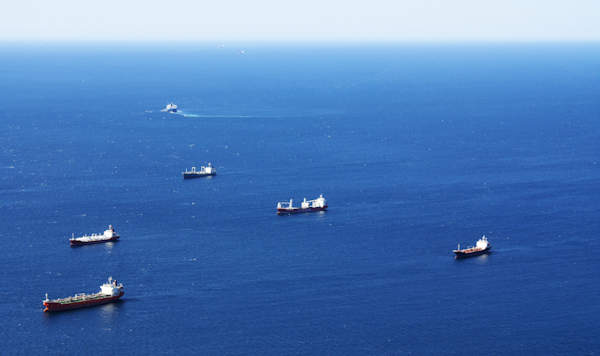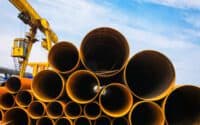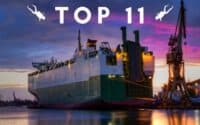The Evolution and Challenges of Maritime Traffic

The Crucial Role of Maritime Traffic
Maritime traffic, simply put, is the movement of ships and boats across our vast oceans and waterways. Have you ever stopped to think about where the products you use every day come from? That coffee you drank this morning, the laptop you’re working on, or even the clothes you wear – many of these items might have traveled thousands of miles across seas to reach you. Maritime traffic plays an instrumental role in the global economy, ensuring goods are transported efficiently from one corner of the world to another.
* Please send feedback/suggestions to editor @ shipuniverse.com
Tackling Today’s Maritime Challenges
Yet, it’s not always smooth sailing on the open waters. Today’s maritime routes face several challenges. Congested waterways, changing environmental concerns, and the sheer increase in the volume of vessels can sometimes lead to complications. How we address and manage these challenges directly affects our global trade, economy, and environment.
Historical Perspective on Maritime Traffic
The Ancient Water Highways
Before the invention of airplanes or cars, seas and rivers were the primary means of long-distance transportation and trade. Ancient civilizations, from the Pharaohs of Egypt to the maritime prowess of the Greeks and Phoenicians, relied on sea routes to transport goods, explore, and establish trade relations. These routes were like the highways of old, connecting different cultures and economies. But just like today’s highways, they weren’t without their challenges. Navigating through uncharted waters, facing the unpredictable nature of the sea, and dealing with pirates were common issues sailors of the past had to contend with.
How Maritime Traffic Management Evolved
Over time, as more and more nations started to realize the importance of maritime trade, there was a pressing need to better manage the traffic on these water highways. Lighthouses were built to guide ships and prevent them from crashing into coastlines. Maps became more detailed and accurate, helping sailors navigate more confidently. Agreements between nations established certain sea routes, reducing potential conflicts. As technology advanced, so did our approach to maritime traffic management. From relying on stars for navigation, we moved on to compasses, and today, we have advanced GPS systems guiding our ships. Each era brought with it new challenges but also new innovations to help manage the ever-growing maritime traffic.
Current Maritime Traffic Challenges
A Sea Full of Ships
Imagine a busy highway during rush hour, but instead of cars, it’s filled with massive ships, small boats, and everything in between. That’s what our oceans look like today. With the boom in global trade and the ever-growing global economy, there are more vessels on the water than ever before. This increase makes managing maritime traffic a lot trickier. Think of it like trying to find a parking spot at a popular event; the more cars (or in this case, ships) there are, the more challenges arise.
The Ocean’s Health is Our Health
Our oceans are not just pathways for ships; they’re also home to countless marine species and ecosystems. But the increased traffic has led to environmental concerns. Ships might accidentally spill oil or release harmful ballast water. Plus, the noise from these vessels can disturb marine life. As we use the oceans for our benefit, it’s our responsibility to ensure they remain clean and healthy.
Navigating Tight Spaces
Some parts of the world’s oceans are like narrow alleyways – tricky and tight. Places like the Suez Canal or the Strait of Malacca are narrow yet crucial for global trade. With more ships passing through these chokepoints, the risk of accidents, blockages, or collisions goes up. It’s a bit like driving a large truck through a narrow street; precision and care are paramount.
Safety First: Beyond Natural Challenges
While navigating the vast oceans, ships not only deal with natural obstacles but human-made ones too. Piracy, theft, and security threats remain significant concerns. Some regions are more prone to pirate attacks, making it essential for vessels to have security measures in place.
The Need for Advanced Maritime Traffic Management Solutions
Driving Global Trade
Let’s face it: without ships, our world would look very different. Maritime traffic is the backbone of global trade. It’s how we get our electronics, cars, food, and so much more. With the challenges faced by this sector, we need advanced management solutions to ensure trade continues smoothly. If the maritime traffic stalls, so does our access to essential goods.
Protecting Mother Earth
Advanced traffic management isn’t just about preventing ship collisions; it’s also about environmental sustainability. With better systems in place, ships can optimize their routes for fuel efficiency, reducing pollution. Plus, with proper oversight, we can prevent environmental disasters before they happen.
Safety is No Accident
Every ship that sets sail has crew members on board. Their safety, along with the safety of the marine environment and cargo, is of utmost importance. Advanced traffic management tools can predict potential hazards, track ships in real-time, and offer guidance for safe navigation. In essence, they act like the traffic lights and signs of the ocean, ensuring every journey is a safe one.
Technological Advancements and Solutions
A. Automated Identification Systems (AIS) – The Maritime ID Card
What is AIS?
Think of AIS as a digital ID card for ships. It’s a system that vessels use to share information about themselves with other ships and with coastal authorities. Details like the ship’s position, course, speed, and other vital data are continuously broadcasted.
Why is AIS a Game-Changer?
With AIS, tracking ships becomes a breeze. It’s like having a live map showing where every ship is at any given moment. This real-time data helps avoid collisions and assists authorities in managing maritime traffic efficiently.
Sites using AIS
- MarineTraffic (marinetraffic.com)
One of the most popular ship tracking services globally, MarineTraffic provides real-time data on the movements of ships, as well as other maritime information. - VesselFinder (vesselfinder.com)
Similar to MarineTraffic, VesselFinder offers real-time data about vessels around the world. - AIS Hub (aishub.net)
A community-driven platform where members share AIS data freely, providing an overview of ship movements. - ShipFinder (shipfinder.co)
This site is straightforward and offers a real-time map of ships worldwide. - MyShipTracking (myshiptracking.com)
It provides a map of real-time ship movements and offers additional details about each ship. - FleetMon (fleetmon.com)
Another extensive platform offering real-time tracking, FleetMon also has vessel photos, port databases, and other features for maritime enthusiasts. - Live AIS Ship Tracking (ship-tracking.com)
This is another option for tracking ships in real-time across the world.
B. Digital Twins and Simulation – A Virtual Maritime World
Crafting a Digital Replica:
Digital Twins are like video game versions of real-world objects. By gathering real-time data, these simulations create an exact virtual copy of ships and ports. It’s a bit like having a virtual ship inside a computer.
Benefits of Virtual Testing:
By using these virtual replicas, we can foresee and manage traffic patterns, ensuring that real-world operations run smoothly. Additionally, it’s possible to test various scenarios in the virtual world first, optimizing strategies before implementing them in reality.
C. Eyes in the Sky: Satellite-Based Monitoring and Surveillance
The Power of Wide-Area Monitoring:
Satellites give us a bird’s-eye view of vast oceanic stretches, allowing us to monitor multiple ships across large areas simultaneously.
Ensuring Safe Journeys:
With such comprehensive oversight, we can detect potential collision courses and prevent ships from running aground. Additionally, these “eyes in the sky” offer an extra layer of security, aiding in the detection and deterrence of pirate activity.
D. Smart Sailing with Artificial Intelligence (AI) and Predictive Analytics
Anticipating Maritime Traffic Jams:
Just as AI can predict traffic jams on roads, it can also foresee congestion in maritime routes, helping ships to avoid delays.
Smarter, Optimized Routes:
AI doesn’t just predict; it optimizes. By analyzing vast amounts of data, AI can suggest the best routes for ships, ensuring they consume less fuel and reach their destinations faster.
E. The Future is Here: Autonomous and Remote-Controlled Vessels
Self-Sailing Ships:
Technological advancements have paved the way for ships that can navigate themselves without constant human oversight, similar to self-driving cars but on water.
Why Go Autonomous?
By reducing the reliance on human intervention, we can decrease the chances of errors. These autonomous ships can be more efficient, saving both time and resources.
F. Sailing Green: Eco-friendly Innovations
Sliding Smoothly with Air Lubrication:
Imagine ships floating on a cushion of bubbles. Air lubrication systems create a layer of air beneath ships, reducing water resistance and saving fuel.
Powering Up the Green Way:
As the world moves towards cleaner energy, the maritime industry isn’t left behind. Hybrid and electric propulsion systems are making waves, allowing ships to operate with a smaller carbon footprint.
Non-Technological Solutions
A. Upping the Game: Enhanced Training and Certification for Seafarers
Why Training Matters:
While technology plays a huge role in modern maritime operations, the human element remains crucial. Seafarers, from captains to deckhands, are at the heart of every voyage. To ensure their skills are up-to-date, it’s vital they receive proper training.
Focus on the Now:
The seas aren’t what they used to be. With changing maritime challenges, training programs need to highlight the role of new technologies and how to harness them effectively. It’s not just about sailing anymore; it’s about understanding and integrating technology into daily operations.
B. Universal Playbook: International Maritime Traffic Regulations and Standards
One Sea, One Set of Rules:
The ocean knows no boundaries. As ships sail from one country to another, having different rules can be confusing and counterproductive. That’s where a universal set of maritime regulations comes into play. Imagine it as a rulebook that every nation agrees upon, ensuring that there’s no ambiguity on the high seas.
Strength in Unity:
Maritime challenges can’t be tackled single-handedly. Collaborations among nations are essential to ensure global maritime operations run like a well-oiled machine. These partnerships ensure that rules are followed, and any emerging challenges are addressed collectively.
C. Ports of the Future: Designing Efficient Port Infrastructure
The Role of Smart Design:
Ports are the hubs of maritime traffic, much like airports for planes. As such, their design plays a pivotal role in managing traffic. A well-designed port, with a logical layout and adequate facilities, can greatly reduce congestion, ensuring ships move in and out efficiently.
Scaling Up:
With ships becoming larger and more numerous, ports need to evolve. This means deeper berths, longer quays, and more advanced equipment. It’s like upgrading a parking lot to accommodate more, and bigger, vehicles, ensuring there’s no bottleneck in maritime traffic.
The Road Ahead: The Future of Maritime Traffic Management
Gazing into the Maritime Crystal Ball
As we survey the vast expanse of the maritime industry, a few trends are evident. We’re witnessing a move towards greater automation with advanced technologies like AI steering the way. Ships might soon become more self-reliant, capable of making decisions based on vast data sets.
Walking the Tightrope: Humans and Automation
While the allure of automation is strong, there’s an ongoing debate about the balance between machine and man. Can we entirely trust machines to oversee all maritime operations? It’s a bit like wondering if self-driving cars can entirely replace human drivers. There will always be scenarios where human judgment and intuition play an irreplaceable role. The future might not see a complete handover to machines but rather a harmonious collaboration between tech and touch.
The Ethics of the Automated Seas
Beyond practicality, there’s an ethical dimension to consider. What happens in the event of an unforeseen maritime incident involving an automated ship? Who’s accountable? The introduction of fully automated systems doesn’t just change how things work; it also raises crucial moral questions we need to address.
Reflecting on the Voyage
Maritime traffic is more than just ships moving across water. It’s the lifeblood of our globalized world, connecting economies and cultures. As we’ve seen, managing this traffic is no small feat, and as challenges evolve, so must our solutions.
Charting New Waters Together
The horizon is vast, and the seas are deep. But with continuous innovation, combined with collaboration among all stakeholders, we can ensure that maritime traffic remains efficient, safe, and sustainable. It’s not the task of a single ship or nation, but a collective journey. So, let’s set sail together towards a brighter maritime future.

Do you have a Maritime Product or Service that may be of interest to Shipowners? Tell us about it here!
Do you have feedback or insights? Please reach out to editor @ shipuniverse.com



